Human Spaceflight: The First 50 Years
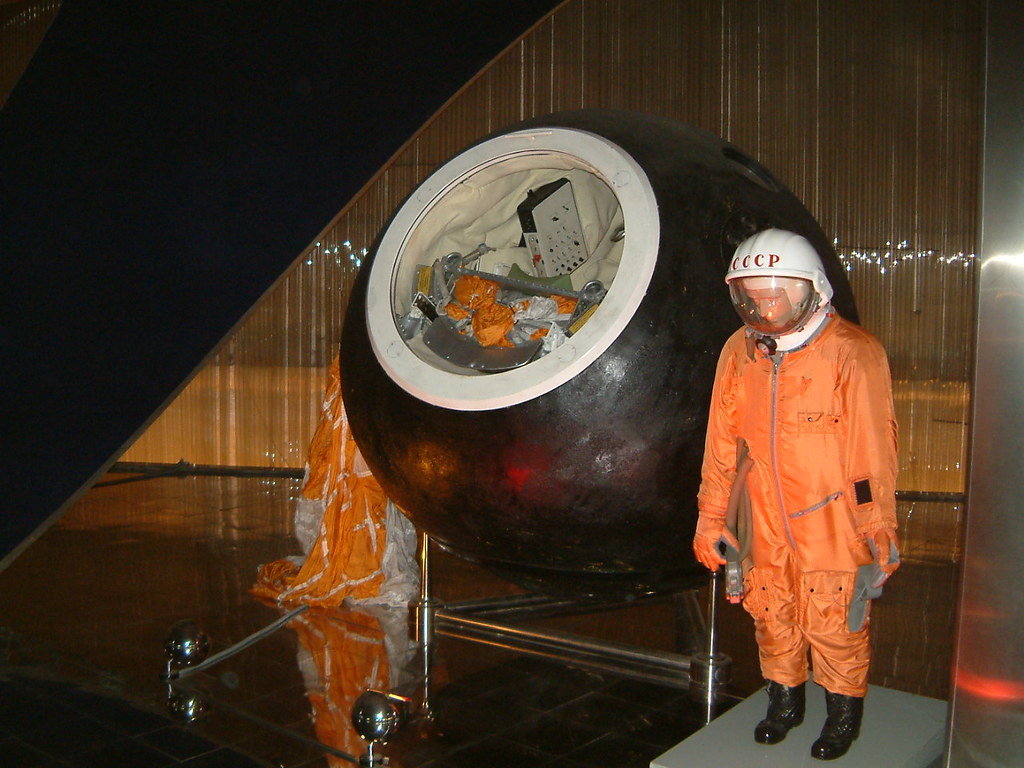
Yuri Gagarin Capsule and space suit (greenacre8, Wikimedia Commons)

Yuri Gagarin Capsule and space suit (greenacre8, Wikimedia Commons)
How does this align with my curriculum?
A history of the first 50 years of human space flight.
In the Beginning
If the idea of blasting into outer space sounds absolutely amazing, then you are not alone. For a long time humans observed space from a distance, because travelling beyond our planet was not yet possible. It would be a while before technology allowed people to send objects into space.
Human's first real step towards space exploration happened during World War II. This was when Germany engineered their A4/V-2 rocket. Its first successful test flight reached an altitude of 84.5 kilometres.
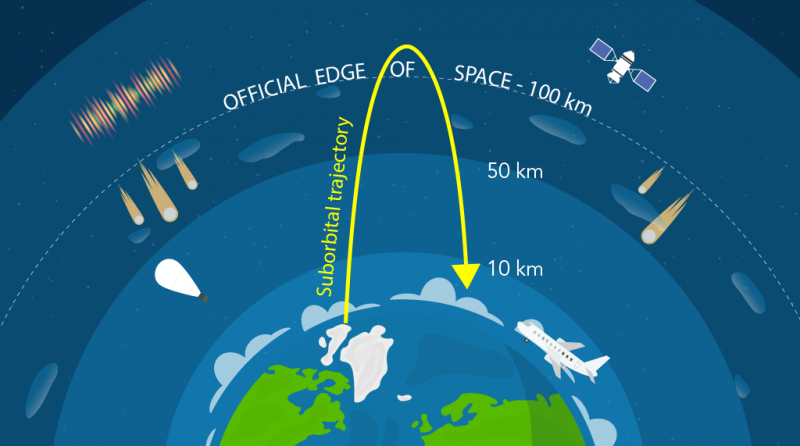
Image - Text Version
Shown is a colour infographic of the Earth and atmosphere and a typical trajectory of a suborbital flight. The top half of the Earth is visible at the bottom centre of the image. Ove this is a pale blue layer that surrounds the Earth. In this layer are clouds and a jet airliner. The top edge of this layer is marked as having an altitude of 10 km. Above this is a darker blue layer. In this layer is a weather balloon. The top edge of this layer is marked as having an altitude of 50 km. Above this is a darker blue layer. Meteors can be seen in this area. The top edge of this layer is marked with text and a dashed line identifying it as the official edge of space. The altitude of this is 100 km. The suborbital path is marked with a thin yellow line with an arrow at the end pointing towards the Earth. The shape of the line is a parabola with the apex being just above the official start of space.
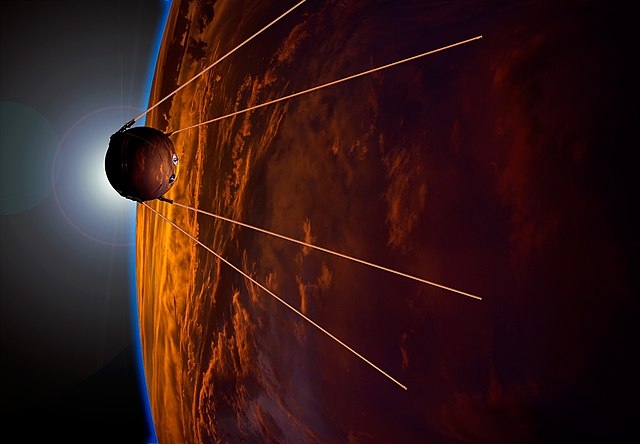
Image - Text Version
Shown is a colour digital painting of Sputnik in orbit around the Earth. The Earth takes up most of the frame. The clouds have a rusty colour, as if at sunset. Sputnik, which is a shiny sphere, is reflecting colour from the Earth on its right side, and the blackness of space on its left. Sputnik's four long antennas stick out like legs on its right side. On the left, behind the Earth, the sky is black except for the silhouette of the Sun peeking out from behind Sputnik.
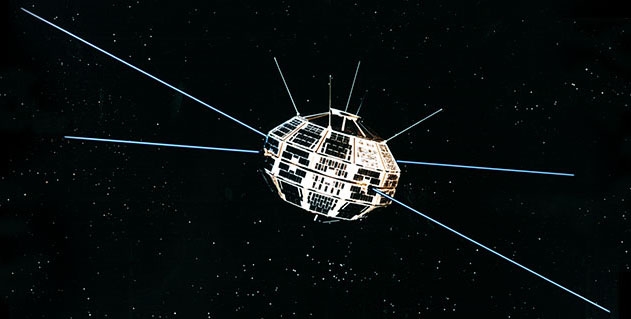
Image - Text Version
Shown is a colour photograph of the Alouette 1 satellite against a starry black background. Unlike Sputnik, which was close to a perfect sphere, Alouette is like a flattened sphere with flat, highly mirrored surfaces. Four long thin main antennas stick out sideways, like the points on a compass. Four smaller antennas point upwards from the top of the satellite.
Animals in Space
Before human space missions, people needed to figure out one very important thing. Was it even possible for living things, such as animals, to survive in space? To find out, scientists sent animals into space to experience the effects of on living things.
Did you know?
Six countries have sent animals into space. These include the Soviet Union/Russia, the United States, France, China, Japan and Iran.
The first animals sent into space were fruit flies. They were aboard a United States V-2 rocket on February 20, 1947. The capsule they were in was able to come back to Earth safely and the fruit flies were found alive. In 1949, Albert II, a rhesus monkey, became the first monkey into space. He too rode atop a V-2 rocket. Sadly for Albert, his parachute failed to open upon returning to Earth.
Two years later, the Soviet Union launched two dogs – Tsygan and Dezik – into space. These two dogs became the first mammals to visit space and return safely back to Earth.
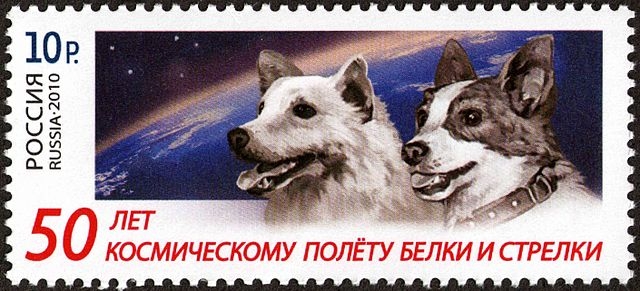
Image - Text Version
Shown is a colourful stamp featuring the dogs Belka and Strelka. They were the first mammals to travel safely to space and back.
The heads of the two dogs can be seen in the foreground. The one on the left has a white coat, and the other is white with grey colouring on both sides of its face, covering over the eyes and ears.
In the background is the Earth's surface against a starry space background. There is black and red Russian text on the left and bottom border of the stamp.
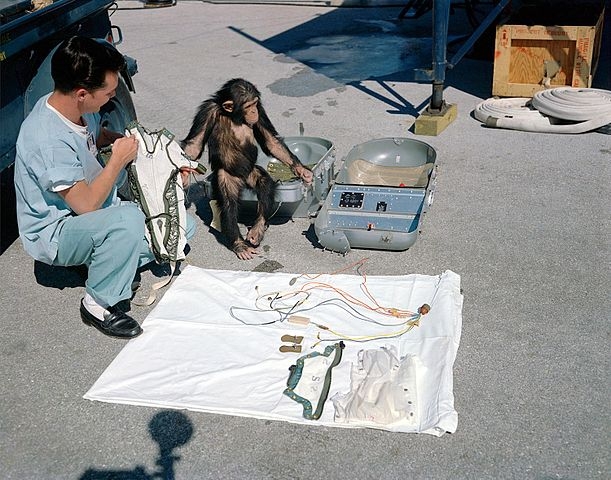
Image - Text Version
Shown is a colour photo of Ham the chimp and a technician going over the flight equipment before the chimp's suborbital flight. In the foreground, a white cloth is spread out picnic-style, with colourful wires and other fastenings laid on top of it. The technician is kneeling on the concrete floor of Hanger S and Ham stands next to him, the two are holding his space garment. Ham the chimp is standing near the two halves of his light blue capsule.
Did you know?
Ham was trained to push certain buttons and pull certain levers – which he did! The success of Ham’s flight led directly to the first US human space flight.
Human Space Flight
For more than fifty years, people have been going into space themselves. These men and women are called . The word “astronaut” comes from ancient Greek words meaning ‘sailors of the stars’. Russians call their astronauts cosmonauts and the Chinese call theirs . Together, they command, pilot, or serve as a crew member of a spacecraft. Until recently, the only way you could become an astronaut was by working for a government space agency, such as the National Aeronautics and Space Administration (NASA) in the United States or the Canadian Space Agency (CSA) in Canada.
This changed in 2001, when multimillionaire Denis Tito used $20 million of his own money to fly in a Soyuz capsule. He spent a week at the (ISS), creating a new category of astronauts called . Canadian Guy Laliberté, of Cirque du Soleil, did the same thing in 2009. Several companies are now offering suborbital space flights, with costs starting at $250 000 US per passenger. That is one big ticket!
Let’s see how human space flight got to where we are today.
Solo Missions
In the late 1950s, the space race continued to build up speed. Both the United States and the Soviet Union began preparing to put humans into space. The Soviet Union was set on launching a manned orbital mission before the Americans.
Vostok Program
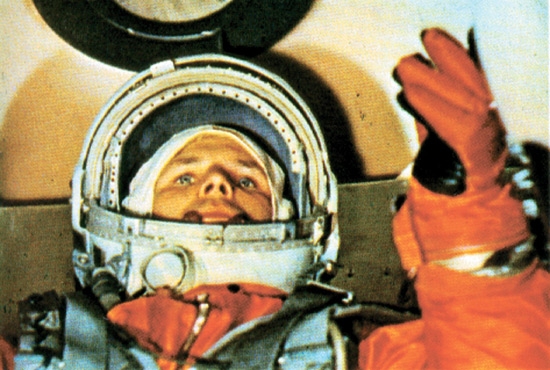
Image - Text Version
Shown is a colour photo of cosmonaut Yuri Gagarin. The photo was taken from the chest up. Gagarin is wearing his white helmet with the visor up, and his orange space suit. He is leaning back and looking up, while lifting his left arm in the air. A safety harness appears to be strapped around his shoulders.
During his flight, which lasted just under two hours, Gagarin orbited the Earth once. He landed by parachute a few hundred kilometres away from his launching point. This surprised a farmer and her daughter as he floated down with his bright orange suit! There were six manned space flights in the Vostok program between 1961 and 1963.
Did you know?
Cosmonaut, Valentina Tereshkova, launched into space in 1963. This made her the first woman in space.
Project Mercury
The United States responded to Gagarin’s flight a month later with Project Mercury. On May 5, 1961, Alan Shepard launched into space in a Mercury capsule aboard a Redstone rocket. Just like Ham the Chimp! Unlike Gagarin’s orbital flight, Alan Shepard only made a suborbital flight. Shepard's flight lasted 15 minutes.
Less than three weeks later, the space race went into high gear. US President John F. Kennedy made the bold promise to send an American to the Moon by the end of the decade. This is when the ‘space race’ became the ‘race to the Moon.’
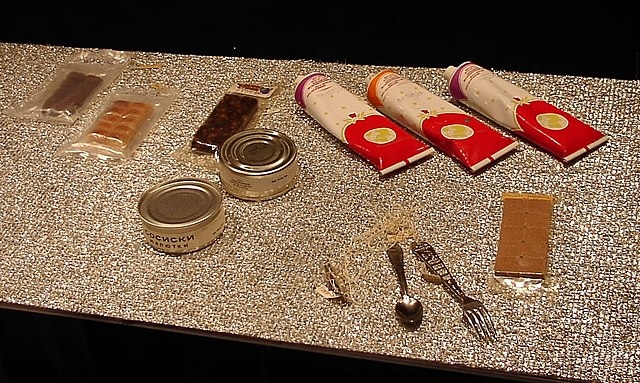
Image - Text Version
Shown is a colour photograph of space food in a museum. Displayed on a gray table are examples of early space food provided to cosmonauts. In the back are packaged freeze-dried cubes in various shades of brown. Two tin cans and three white and red tooth-paste like tubes. Silver cutlery is displayed in the foreground.
When nature called on board these early capsules, there wasn’t room for toilets. Urine and solid waste were both collected in bags worn inside the astronaut’s spacesuits. Needless to say, the astronauts were not thrilled with this system. Those who had been fighter pilots were already used to this unpleasant experience.
Travelling With a Friend: Two-person Missions
Voskhod Program
The follow-up to the Soviet Vostok program was the Voskhod program. It included two manned missions using the Voskhod spacecraft and rocket. The main reason for this program was to put the first multi-person crew into orbit. The crew of Voskhod 1 were the first not to use spacesuits. They were also the first to carry a medical doctor into space. A final first of the program was the first spacewalk, or , by Alexey Leonov during the Voskhod 2 mission in 1965.
Project Gemini
Project Gemini was the second American human orbital spaceflight program. It used a two-person spacecraft to develop skills such as docking and spacewalks. Ten manned flights happened between 1965 and 1966. More than anything, the missions were to prepare astronauts for the upcoming Apollo program.The goal of this program was to get a man on the Moon.
Did you know?
Gemini missions also included a new and improved selection of food for the astronauts. The menu included shrimp cocktail, chicken and vegetables, toast, butterscotch pudding, and apple juice.
One Giant Leap to the Moon
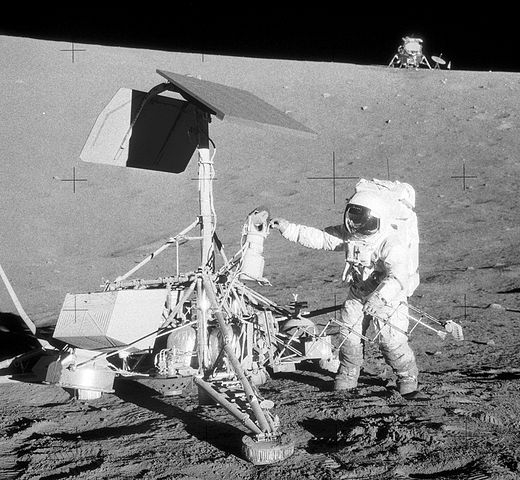
Image - Text Version
Shown is a black and white photo of Surveyor 3 and Astronaut Charles "Pete" Conrad during the Apollo 12 mission. The surveyor's frame is sitting on its three landing pads like a tripod. Two solar panels can seen at the top of the surveyor, spreading out like wings of a bird. Astronaut "Pete" is standing to the right of the surveyor, his right arm is lifted towards the surveyor's camera.
Apollo Program
Having successfully sent multi-person crews into space and having landed probes on the Moon, the Soviet Union and United States were ready to send people to the Moon.
This time, it was the American Apollo program that made it to the Moon first. Between 1969 and 1972, NASA sent 7 three-man missions to land on the surface of the Moon. These were the first and – so far – only human missions to another world.
The program was off to a rocky start when, on January 27, 1967, a launch pad fire killed astronauts Gus Grissom, Ed White and Roger Chaffee aboard Apollo 1. Both unmanned (Apollo 4, 5, 6) and manned (Apollo 7 and 8) test flights followed. Two more important dress rehearsals would occur before the actual Moon landing. The crew of Apollo 9 tried out the and the Portable Life Support System that would be used on the lunar surface. The crew of Apollo 10 went to the Moon and brought their LM down to 15 kilometres above the lunar surface.
They Finally Made It!
On July 20, 1969, an estimated 600 million people around the world watched the Apollo 11 mission Moon landing. When American astronaut Neil Armstrong stepped on the surface of the Moon, he said his famous phrase, “That’s one small step for [a] man… one giant leap for mankind.” The Apollo 11 crew included Neil Armstrong, Michael Collins and Buzz Aldrin. They were on the Moon for slightly more than two and half hours. During that time, they explored the lunar surface, played around in low gravity (1/6 that of Earth), and collected 21.5 kilograms of lunar material. Not bad for such a short visit!
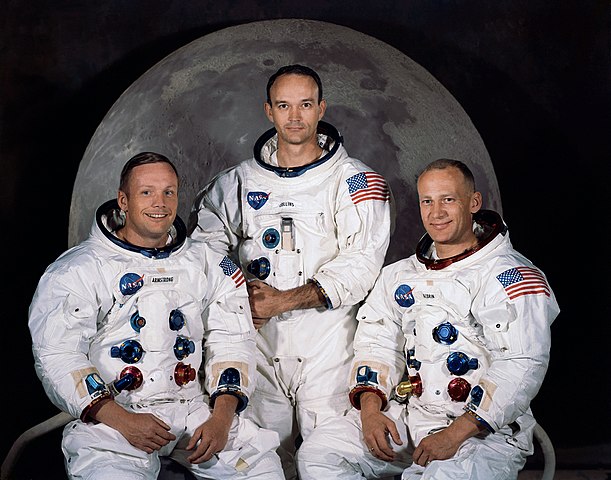
Image - Text Version
Shown is a colour photo of the Apollo 11 crew taken at NASA. From left to right are Neil A. Armstrong, Michael Collins, and Edwin E. "Buzz" Aldrin Jr.. All are smiling for the camera, except for Michael Collins. The astronauts are seen wearing white space suits without helmets, and a badge of the American flag on their left shoulders. Behind them is an image of the moon on a black background.
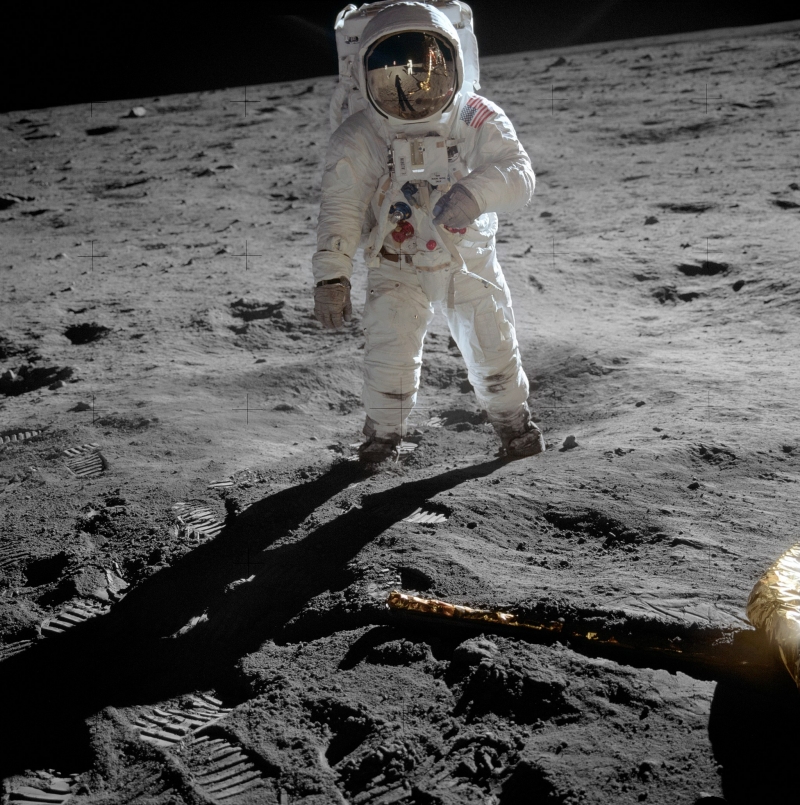
Image - Text Version
Shown is a colour photo of Buzz Aldrin on the Moon in his white NASA space suit. Neil Armstrong can seen in the helmet's reflection. Aldrin casts a shadow in front of him and to his right. He stands on the uneven, grey terrain of the Moon's surface. Boot prints and the bronze metal leg of the landing pad can be seen in the foreground.
The Apollo 13 mission had problems that prevented its crew from landing on the Moon, but the other five missions (Apollo 12, 14, 15, 16, 17) put astronauts on the Moon’s surface.
While on the lunar surface, they did science experiments, and set up permanent gear for future missions. They installed Reflectors for lasers used on Earth. They even collected 382 kilograms (842 pounds) of soil and rocks for analysis.
No human has stepped on the Moon since December 1972. But more recently, there has been renewed interest in going back to the Moon. Not only for science, but also to set up bases for launching missions to Mars.
Soyuz Program
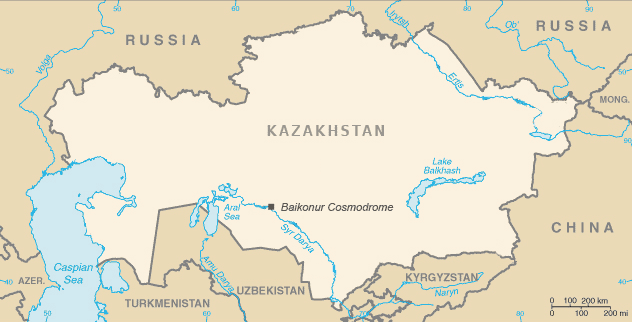
Image - Text Version
Shown is a political map with Kazakhstan in the centre. Kazakhstan is bordered by China and Mongolia in the east, Russia on the north, Turkmenistan, Uzbekistan, and Kyrgyzstan on the south and the Caspian Sea is to the west. The Baikonur Cosmodrome is located in an area of southern Kazakhstan.
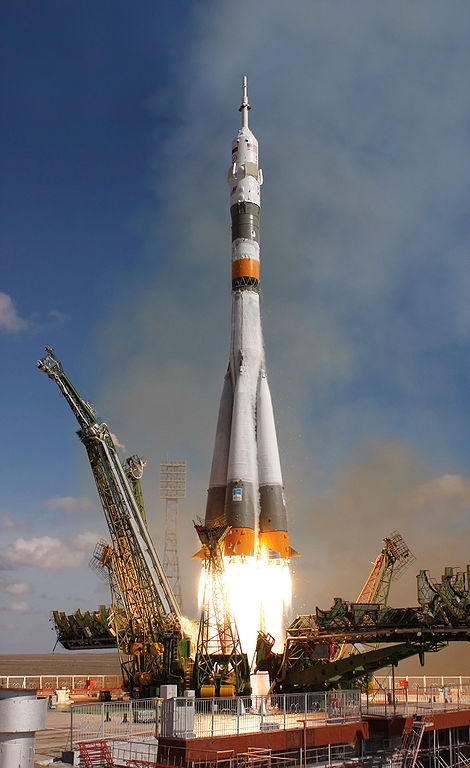
Image - Text Version
Shown is a colour photo of the slim white, grey, and orange Soyuz rocket leaving the launch pad. Bursts of light can be seen below the rocket's four engines. The launch tower supports are falling away from the rocket.
Shuttling Back and Forth
The 1980s marked the beginning of the NASA Space Shuttle program. The Space Shuttles had the capacity for up to eight astronauts. It was a reusable space plane that launched like a rocket but landed like a glider.
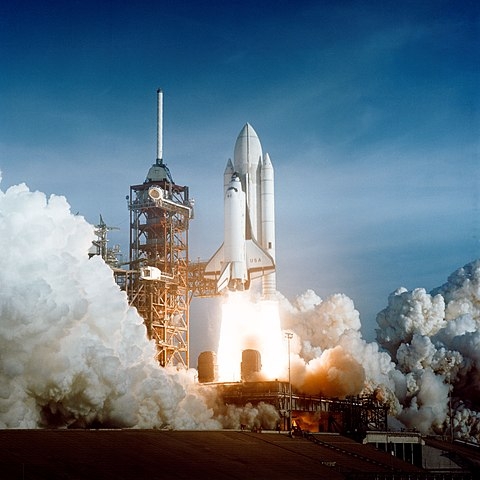
Image - Text Version
Shown is a colour photograph of the Space Shuttle Columbia seconds after liftoff from the launch pad. The launch tower is to its left against a blue sky with wisps of white clouds in the background. Columns of white hot light and clouds of white smoke can be seen under the main engines of the shuttle and the solid rocket boosters.
Six of these huge space planes were built and five flew in space over 30 years (1981-2011). Two tragic losses occurred during the space shuttle program. In 1986, space shuttle Challenger exploded seventy-three seconds after its launch. The other was the break-up on re-entry of the space shuttle Columbia in 2003.
Did you Know?
Marc Garneau was the first Canadian in space aboard STS-41 in 1984. He was also the first Canadian to go to space a second time. Roberta Bondar was the first Canadian woman in space aboard STS-42 in 1992. A total of eight Canadians have flown on space shuttle missions.
Looking Back and Facing Forward
Looking back, incredible sacrifices were made and hard work put forth by many to advance human exploration. Including men and women space pioneers who braved the early flights, before many safety features were even developed. Facing forward, we have set our sights on going to Mars. We have had some successes already, but still have many issues to overcome before humans can set foot on Mars. Who knows, maybe you will be there to watch it happen!
Learn More
The Sputnik 1 Launch: The First Artificial Satellite To Enter Earth's Orbit (2017)
This YouTube video (2:05 min.) has information as well as historical film and photos from the launch of Sputnik 1.
Alouette I and II
Information about Alouette I and II from the Canadian Space Agency
Animals in Space
This page from NASA has more information about animals in space.
What Was Project Mercury?
This page from NASA has more information about the Mercury space program.
The Apollo Program: How NASA sent astronauts to the moon
This article, from Space.com, has an overview of the history and accomplishments of NASA's Apollo missions.
What Is the Soyuz Spacecraft?
This page from NASA has more information about the Soyuz spacecraft.
Space missions
This page on the Canadian Space Agency website has links to information about Canadians involved in space shuttle missions.
References
European Space Agency (n.d.). The Russian Soyuz Spacecraft. Retrieved from https://www.esa.int/Enabling_Support/Space_Transportation/Launch_vehicles/The_Russian_Soyuz_spacecraft
Gray, T. (1998). A Brief History of Animals in Space. NASA. Retrieved from https://history.nasa.gov/animals.html
Howell, E. (Aug 20, 2018). Project Mercury: America’s 1st Crewed Space Program. Space.com. Retrieved from https://www.space.com/24638-project-mercury.html
Mann, A. (Jul 28, 2020). The Vostok Program: The Soviet’s first crewed spaceflight program. Space.com. Retrieved from https://www.space.com/vostok-program.html
NASA (n.d.) Space Shuttle. Retrieved from https://www.nasa.gov/mission_pages/shuttle/main/index.html
NASA (n.d.) Sputnik 1. NASA Space Science Data Coordinated Archive. Retrieved from https://nssdc.gsfc.nasa.gov/nmc/spacecraft/display.action?id=1957-001B
Royal Museums Greenwich (n.d.). What was the first animal sent into space? Retrieved from https://www.rmg.co.uk/stories/topics/what-was-first-animal-space
Smithsonian National Air and Space Museum (n.d.). Earth and Lunar Orbital Missions. The Apollo Program. Retrieved from https://airandspace.si.edu/explore-and-learn/topics/apollo/apollo-program/orbital-missions/